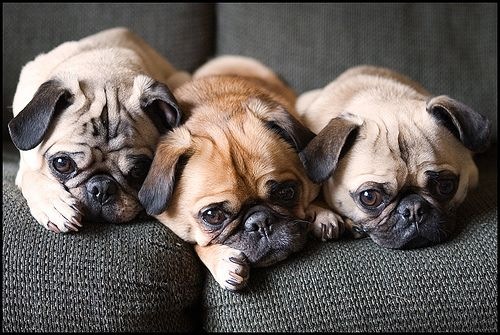The Pug

The history of the pug begins in China. The pug was designed in the Shang dynasty in China, bred to be lap dogs. Originally the pug was known as Lo-Chiang-Sze or Foo. Confucius described circa 551 BCE a dog with a short mouth. As the popularity of the pug grew, the breed expanded from China to Tibet where they were housed with Buddhist Monks, then to Japan before going into Europe becoming a fast favourite in royal courts. In Hollad, the pug was the official dog of the House of Orange and in France popularity grew due to one belonging to Napoleon’s wife. The pug then ventured to Britain after a sack on the Imperial Palace and from then on pugs were imported to various places. The pug has always been a domestic dog and called many names such as the Mopshond, Mops and Carlin.
A pug’s appearance is quite distinguishable from other breeds. It’s small in size, generally favoured for being multum in parvo which means ‘much in little’. Beginning with the large round head, the pug’s eyes are generally very bold, round and prominent with a soft expression. There are deep wrinkles in the forehead and the muzzle is usually quite flat. This is why pugs are known as a brachycephalic breed. Their ears can come in two shapes; the favourable preference is the button but the ears can also be in a ‘rose’ style. The body is very compact and sturdy with moderate laid back shoulders and strong, straight legs. The teeth of a pug form into an undershot bite where the lower teeth protrude further than the upper teeth. The tail is curled and sits very high on the back end.
Pugs come in two colours, either fawn with a black face and ears or solid black. They are generally very affectionate and loving towards their owners. Pugs are very alert and playful and are good with children. They have an exuberant but gentle nature.
To care for a pug one needs to brush out the short bristles of the coat with a standard slicker brush because they shed their coat quite a bit. Regular bathing and brushing can keep shedding down. Pugs are very prone to dry skin and need a moisturising shampoo but the eyes are very sensitive so no shampoo can go near them. The pug’s wrinkles can become very dirty and are prone to infection if they are not wiped out. Pug’s are curious and will shove their faces into anything and everything so it is important for the wrinkles to be cleaned.
Pugs cannot control their body temperature and can become very overheated on hot days. There should always be plenty of water around and if left alone, they should be in an air conditioned room. A cold hand towel or ice pack can be pressed against their stomachs until they are cool. Pugs need to be exercised but not overly. Pugs are more willing to exercise when it is cool outside and just around the block or so.
Pugs, by my own experience, are very popular in the show ring and a popular breed all around. The pug is in the top 20 dog breeds for both the American Kennel Club and United Kingdom Kennel Club. Pugs are commonly shown in the media such as television and film including Men in Black, Hotel for Dogs, Milo and Otis, Pocahontas, Marie Antoinette, The King of Queens, Eastenders and so on.
Of course there are many variations in temperament and health problems and no two pugs are the same.




